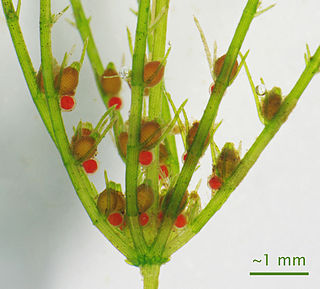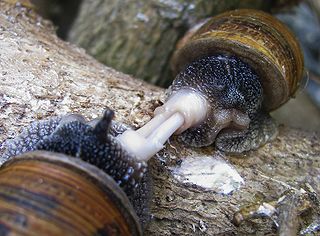
A sex organ, also known as a reproductive organ, is a part of an organism that is involved in sexual reproduction. Sex organs constitute the primary sex characteristics of an organism. Sex organs are responsible for producing and transporting gametes, as well as facilitating fertilization and supporting the development and birth of offspring. Sex organs are found in many species of animals and plants, with their features varying depending on the species.

The uterus or womb is the organ in the reproductive system of most female mammals, including humans, that accommodates the embryonic and fetal development of one or more embryos until birth. The uterus is a hormone-responsive sex organ that contains glands in its lining that secrete uterine milk for embryonic nourishment.

In vitro fertilisation (IVF) is a process of fertilisation where an egg is combined with sperm in vitro. The process involves monitoring and stimulating a woman's ovulatory process, removing an ovum or ova from their ovaries and letting a man's sperm fertilise them in a culture medium in a laboratory. After the fertilised egg (zygote) undergoes embryo culture for 2–6 days, it is transferred by catheter into the uterus, with the intention of establishing a successful pregnancy.
Reproductive technology encompasses all current and anticipated uses of technology in human and animal reproduction, including assisted reproductive technology (ART), contraception and others. It is also termed Assisted Reproductive Technology, where it entails an array of appliances and procedures that enable the realization of safe, improved and healthier reproduction. While this is not true of all people, for an array of married couples, the ability to have children is vital. But through the technology, infertile couples have been provided with options that would allow them to conceive children.

In sexuality, seduction means enticing someone into sexual intercourse or other sexual activity.

Reproductive success is an individual's production of offspring per breeding event or lifetime. This is not limited by the number of offspring produced by one individual, but also the reproductive success of these offspring themselves.

Parental investment, in evolutionary biology and evolutionary psychology, is any parental expenditure that benefits offspring. Parental investment may be performed by both males and females, females alone or males alone. Care can be provided at any stage of the offspring's life, from pre-natal to post-natal.

A psychological adaptation is a functional, cognitive or behavioral trait that benefits an organism in its environment. Psychological adaptations fall under the scope of evolved psychological mechanisms (EPMs), however, EPMs refer to a less restricted set. Psychological adaptations include only the functional traits that increase the fitness of an organism, while EPMs refer to any psychological mechanism that developed through the processes of evolution. These additional EPMs are the by-product traits of a species’ evolutionary development, as well as the vestigial traits that no longer benefit the species’ fitness. It can be difficult to tell whether a trait is vestigial or not, so some literature is more lenient and refers to vestigial traits as adaptations, even though they may no longer have adaptive functionality. For example, xenophobic attitudes and behaviors, some have claimed, appear to have certain EPM influences relating to disease aversion, however, in many environments these behaviors will have a detrimental effect on a person's fitness. The principles of psychological adaptation rely on Darwin's theory of evolution and are important to the fields of evolutionary psychology, biology, and cognitive science.
In biology and medicine, gravidity and parity are the number of times a female has been pregnant (gravidity) and carried the pregnancies to a viable gestational age (parity). These two terms are usually coupled, sometimes with additional terms, to indicate more details of the female's obstetric history. When using these terms:

Mate choice is one of the primary mechanisms under which evolution can occur. It is characterized by a "selective response by animals to particular stimuli" which can be observed as behavior. In other words, before an animal engages with a potential mate, they first evaluate various aspects of that mate which are indicative of quality—such as the resources or phenotypes they have—and evaluate whether or not those particular trait(s) are somehow beneficial to them. The evaluation will then incur a response of some sort.

A hermaphrodite is a sexually reproducing organism that produces both male and female gametes. Animal species in which individuals are either male or female are gonochoric, which is the opposite of hermaphroditic.
In sexual relationships, concepts of age disparity, including what defines an age disparity, have developed over time and vary among societies. Differences in age preferences for mates can stem from partner availability, gender roles, and evolutionary mating strategies, and age preferences in sexual partners may vary cross-culturally. There are also social theories for age differences in relationships as well as suggested reasons for 'alternative' age-hypogamous relationships. Age-disparate relationships have been documented for most of recorded history and have been regarded with a wide range of attitudes dependent on sociocultural norms and legal systems.
Monogamy is a relationship of two individuals in which they form an exclusive intimate partnership. Having only one partner at any one time, whether that be for life or whether that be serial monogamy, contrasts with various forms of non-monogamy. More generally, the term is used to describe the behavioral ecology and sexual selection of animal mating systems, referring to the state of having only one mate at any one given time. In a human cultural context, monogamy typically refers to the custom of two individuals, regardless of orientation, committing to a sexually exclusive relationship.
Bateman's principle, in evolutionary biology, is that in most species, variability in reproductive success is greater in males than in females. It was first proposed by Angus John Bateman (1919–1996), an English geneticist. Bateman suggested that, since males are capable of producing millions of sperm cells with little effort, while females invest much higher levels of energy in order to nurture a relatively small number of eggs, the female plays a significantly larger role in their offspring's reproductive success. Bateman's paradigm thus views females as the limiting factor of parental investment, over which males will compete in order to copulate successfully.
Sexual division of labour (SDL) is the delegation of different tasks between the male and female members of a species. Among human hunter-gatherer societies, males and females are responsible for the acquisition of different types of foods and shared them with each other for a mutual or familial benefit. In some species, males and females eat slightly different foods, while in other species, males and females will routinely share food; but only in humans are these two attributes combined. The few remaining hunter-gatherer populations in the world serve as evolutionary models that can help explain the origin of the sexual division of labour. Many studies on the sexual division of labour have been conducted on hunter-gatherer populations, such as the Hadza, a hunter-gatherer population of Tanzania. In modern day society, sex differences in occupation is seen across cultures, with the tendency that men do technical work and women tend to do work related to care.
Intralocus sexual conflict is a type of sexual conflict that occurs when a genetic locus harbours alleles which have opposing effects on the fitness of each sex, such that one allele improves the fitness of males, while the alternative allele improves the fitness of females. Such "sexually antagonistic" polymorphisms are ultimately generated by two forces: (i) the divergent reproductive roles of each sex, such as conflicts over optimal mating strategy, and (ii) the shared genome of both sexes, which generates positive between-sex genetic correlations for most traits. In the long term, intralocus sexual conflict is resolved when genetic mechanisms evolve that decouple the between-sex genetic correlations between traits. This can be achieved, for example, via the evolution of sex-biased or sex-limited genes.
Evolutionary aesthetics refers to evolutionary psychology theories in which the basic aesthetic preferences of Homo sapiens are argued to have evolved in order to enhance survival and reproductive success.

In evolutionary psychology and behavioral ecology, human mating strategies are a set of behaviors used by individuals to select, attract, and retain mates. Mating strategies overlap with reproductive strategies, which encompass a broader set of behaviors involving the timing of reproduction and the trade-off between quantity and quality of offspring.
Female intrasexual competition is competition between women over a potential mate. Such competition might include self-promotion, derogation of other women, and direct and indirect aggression toward other women. Factors that influence female intrasexual competition include the genetic quality of available mates, hormone levels, and interpersonal dynamics.

Social selection is a term used with varying meanings in biology.










